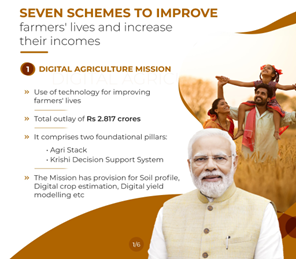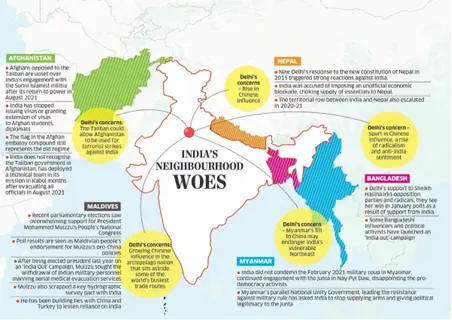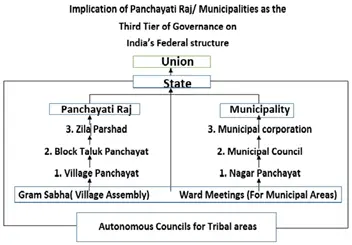Thursday, 5th September 2024
Corporate Tax Cuts Increase Wages
Why in the news?
- In the years prior to the pandemic, two of the largest economies in the world — the U.S. and India — cut corporate tax rates in an attempt to stimulate growth.
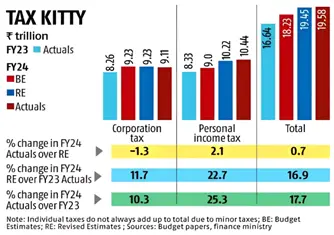
About Corporate Tax:
- Definition: Corporate tax is a direct tax levied on the profits of companies or corporations.
- Rate and Calculation: Corporate tax rates vary by country and are applied to taxable income, which is determined after deducting operating expenses, depreciation, and other allowable deductions from gross revenue.
- Significance: Corporate taxes are a crucial source of government revenue, impacting company investment decisions, business operations, and growth strategies.
- Economic Tool: Lower corporate tax rates are used to attract investment and stimulate economic growth, though their effects on wages, employment, and long-term revenue generation can differ.
The U.S. Experience with Corporate Tax Cuts:
- Legislation: The Tax Cuts and Jobs Act, enacted in 2018 under President Donald Trump, reduced the top corporate tax rate from 35% to 21%.
- Proponents' View: Supporters claimed that this reduction would boost investment, economic growth, employment, and wages, with new investments driving technological advancements and productivity gains.
- Impact Study: The study "Lessons from the Biggest Business Tax Cut in U.S. History," published in the Journal of Economic Perspectives, found that the tax cuts led to a modest increase in investment (8% to 14%), with a limited overall economic impact and a substantial 41% decrease in tax revenue.
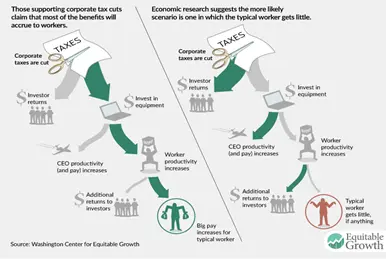
Corporate Tax Cuts in India:
- Tax Rate Reduction: In 2019, India reduced corporate tax rates to 22% for existing companies and 15% for new companies.
- Revenue Impact: This reduction resulted in a significant revenue loss of approximately ₹1 lakh crore in the 2020-21 fiscal year.
- Labour Market Impact:
- The COVID-19 pandemic disrupted the labour market, leading to increased unemployment.
- Although unemployment rates have improved and labour force participation, particularly among women, has risen, the corporate sector's contribution to recovery has been limited.
- Earnings Trends:
- Data from the Periodic Labour Force Survey (PLFS) shows a decline in regular wage employees from 22.8% in 2017-18 to 20.9% in 2022-23.
- From 2017 to 2022, the compound annual growth rate (CAGR) of nominal monthly earnings was 4.53% in rural areas and 5.75% in urban areas, which is only marginally above inflation.
- Real wages in rural areas have declined, and urban wages have stagnated.
- Corporate Tax Collection: Post-pandemic growth in corporate tax collections has not translated into improved employment or wages, with tech companies laying off workers.

Shift in Tax Burden to Individuals:
- Revenue Composition: The share of corporate taxes in India's gross tax revenues decreased from nearly 32% in 2017-18.
- Budget Estimates for 2024-25:
- Corporate Taxes: 26.5% of gross tax revenues
- GST: 27.65%
- Income Tax: 30.91%
- Policy Adjustments: This shift in tax burden has led to the government's decision to remove indexation benefits and tax long-term capital gains to compensate for the reduced share of corporate taxes.

What Lies Ahead?
- Investment Impact: Corporate tax cuts do not guarantee increased investment, especially amidst uncertain future profits.
- Economic Recovery: In economies recovering from the pandemic and facing supply chain disruptions, these tax cuts have had marginal effects on private investment.
- Income Distribution: Tax cuts on profits primarily benefit private capital rather than wage earners, as they boost profits without necessarily driving future investment.
- Policy Recommendations: Economists suggest that maintaining higher taxes on existing profits while providing incentives for future investment may be more effective.
- Complexities: The mixed results of these tax cuts highlight the complexities of policymaking in a global economic environment.
|
UPSC Civil Services Examination PYQ Mains Q:1 Enumerate the indirect taxes which have been subsumed in the Goods and Services Tax (GST) in India. Also, comment on the revenue implications of the GST introduced in India since July 2017. (UPSC-2019) |
Source: TH
Harnessing biotechnology for economic development
Why in the news?
- The Centre's BioE3 (Biotechnology for Economy, Environment, and Employment) policy seeks to transform industrial and manufacturing processes by incorporating sustainable, biologically inspired methods.
- While aimed at boosting the biotech sector, experts view it as a significant step toward the industrialization of biology, with potential major economic impacts.
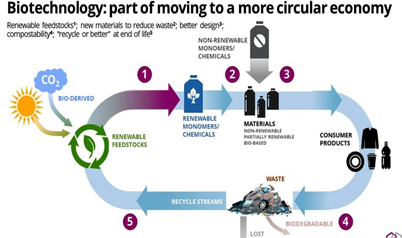
About the Biotechnology:
- About:
- Biotechnology involves using living organisms, biological systems, or their components to develop products and technologies.
- It combines biology and technology to offer solutions in medicine, agriculture, environmental management, and industrial processes.
Applications:
- Medical Biotechnology: New drugs, vaccines, gene therapies, diagnostic tools.
- Agricultural Biotechnology: Genetically modified crops for better resistance and nutrition.
- Environmental Biotechnology: Bioremediation to clean pollutants using microorganisms.
- Industrial Biotechnology: Producing biofuels, biodegradable plastics through biological methods.
Status of Biotechnology in India:
- Percentage Share of Biotechnology Segments:
- BioPharmaceuticals: 62% ($57.5 Bn)
- BioAgriculture: 13% ($11.5 Bn)
- BioIndustry: 15% ($14.1 Bn)
- BioIT & BioServices: 10% ($9.3 Bn)
- Economic Contribution: The biotechnology sector is seen as a key driver for India’s $5 trillion economy target.
- Global Ranking: India ranks among the Top 12 biotechnology destinations worldwide and is the 3rd largest in the Asia Pacific, holding a 3% share in the global biotechnology industry.
- Global Innovation and Economic Status: In 2022, India became the fifth-largest economy globally and was ranked 40th in the Global Innovation Index (GII) Report 2023. It is a leading innovation economy in Central and Southern Asia.
- Market Value: The Indian biotechnology industry was valued at $93.1 billion in 2022, with projections to reach $300 billion by 2030.
Potential of Biotechnology in India:
- Bioresources: India has abundant bioresources, particularly due to its rich biodiversity and unique bioresources in the Himalayas, positioning it advantageously in the global biotechnology arena.
- Youth and Skilled Workforce: With a population of 1.4 billion, and 47% under the age of 25, India boasts a large, skilled workforce crucial for biotechnology growth.
- Sectoral Contributions: The biotechnology sector in India has significantly contributed to areas like health, medicine, agriculture, industry, and bioinformatics.

BioE3 Policy Benefits:
- Introduction to BioE3: India's BioE3 policy prepares the country for a biotechnology-driven economy. It focuses on long-term gains through research, talent development, and biomanufacturing growth.
- Economic Impact: Biomanufacturing, using biological organisms in production, is projected to reach $2-4 trillion over the next decade, boosting economic integration of biotechnology.
- Strategic Alignment: BioE3 aligns with India's AI, Quantum, and Green Hydrogen Missions, promoting global leadership in technology and addressing climate change and energy security.
- Biomanufacturing Hubs: The policy envisions hubs focusing on:
- Bio-Based Chemicals & Enzymes
- Smart Proteins & Functional Foods
- Precision Biotherapeutics
- Climate-Resilient Agriculture
- Carbon Capture & Utilisation
- Marine & Space Research: Producing oxygen, food in space habitats, and novel marine compounds for pharmaceuticals.
Government Initiatives in Biotechnology:
- Startup India & Make in India Programs: These initiatives aim to establish India as a world-class hub for biotechnology and bio-manufacturing, fostering innovation and entrepreneurship in the sector.
- National Biopharma Mission: Supporting 101 projects across over 150 organisations and 30 MSMEs, this mission accelerates biopharma development and innovation.
- India-Finland Collaboration (2022): India and Finland expanded cooperation in biotechnology, digital education, mobile technologies, and ICT under a bilateral agreement.
- Biotechnology Industry Research Assistance Council (BIRAC): Established by the Department of Biotechnology (DBT), BIRAC empowers biotechnology enterprises to undertake strategic research and innovation.
- Biotechnology Parks and Incubators: Set up by DBT across India, these facilities provide infrastructure support for translating research into commercial products and services.
- Favourable Government Policies: Draft R&D Policy 2021, PLI Schemes, and Clinical Trial Rules have enhanced India's global reputation as the "pharmacy of the world."
- FDI Policy: 100% FDI is allowed under the automatic route for greenfield pharma and under the government route for brownfield pharma, with up to 74% allowed automatically.
Way Forward:
- The BioE3 Policy will complement existing government initiatives like the 'Net Zero' carbon economy and 'Lifestyle for Environment' (LiFE).
- It will propel India toward green growth by promoting a circular bioeconomy and aligning with the vision of Viksit Bharat, ensuring a sustainable and innovative future responsive to global challenges.
Source: IE
Zero FIRs filed in local languages
Why in the news?
- Recently, The Union Ministry of Home Affairs (MHA) has directed Union Territories (UTs) to ensure that 'zero FIRs' recorded in local languages are accompanied by a translated copy of the same when forwarded to states with different languages.

About FIRs:
- The term "First Information Report" (FIR) is not explicitly defined in the Indian Penal Code (IPC), Code of Criminal Procedure (CrPC), or any other law.
- However, in police regulations, information recorded under Section 154 of CrPC is referred to as an FIR.
- Section 154 mandates that any information regarding the commission of a cognizable offence, if provided orally to a police officer in charge, must be reduced to writing.
- A copy of the recorded information must be given to the informant free of cost.
- Key elements of an FIR include:
- It must pertain to a cognizable offence.
- It should be reported orally or in writing to the police station head.
- It must be documented, signed by the informant, and its contents entered in a daily diary.
Zero FIRs
- A Zero FIR can be lodged at any police station by the victim, regardless of where they reside or where the crime took place.
- Upon receiving a Zero FIR, the police station forwards it to the appropriate jurisdiction for further investigation.
- The FIR does not receive a regular number, and a fresh FIR is registered by the concerned police station.
- The concept of Zero FIR was introduced following the Justice Verma Committee recommendations after the 2012 Nirbhaya gang rape case.
- The aim is to prevent delays and ensure that victims do not face hurdles in getting their complaints registered.
- The provision ensures faster action after filing the FIR, aiding in timely redressal of grievances.
FIRs under New Criminal Laws:
- The three new criminal laws—Bharatiya Nyaya Sanhita 2023, Bharatiya Nagarik Suraksha Sanhita 2023, and Bharatiya Sakshya Adhiniyam 2023—came into effect from July 1, 2024.
- These laws replaced the IPC, CrPC, and the Indian Evidence Act, respectively.
- Under the new laws, FIRs can now be reported via electronic means, eliminating the need for physical visits to police stations.
- This facilitates quicker reporting and enables faster action by law enforcement.
- The Bharatiya Nagarik Suraksha Sanhita (BNSS) mandates the registration of a ‘Zero FIR.’
- Section 176(3) of BNSS requires mandatory collection of forensic evidence and video recording of crime scenes in cases punishable by seven years or more.
- States lacking forensic facilities can use those of other states.
- Victims receive a free copy of the FIR, ensuring their active participation in the legal process.
Source: IE
Aparajita Bill
Why in the news ?
- The Aparajita Woman and Child (West Bengal Criminal Laws Amendment) Bill 2024 has been unanimously approved by the West Bengal Assembly.
- This Bill mandates the death penalty for rape cases where the victim either dies or is left in a permanent vegetative state.
- The approval of this Bill follows significant public protests in West Bengal in response to the rape and murder of a young doctor at R.G. Kar Medical College and Hospital in Kolkata.

Current Indian Laws to Curb Sexual Assaults on Women:
- Criminal Law (Amendment) Act 2013
- Amended the Indian Penal Code (IPC) to permit the death penalty in cases of rape resulting in death or a persistent vegetative state, and for repeat offenders.
- Criminal Laws (Amendment) Act 2018
- Introduced the death penalty for rape and gang rape involving girls under the age of 12.
- Bhartiya Nyaya Sanhita 2023
- Maintains previous penal provisions and adds the death penalty for gang rape of women under 18 years of age.
Salient Provisions of the Aparajita Bill:
- Amendments to Existing Laws
- The Bill revises the Bharatiya Nyaya Sanhita 2023 (BNS), the Bharatiya Nyaya Suraksha Sanhita 2023 (BNSS), and the Protection of Children Against Sexual Offences Act 2012 (POCSO).
- Provisions of BNS Revised
- Adds “or with death” to the maximum punishment descriptions for aggravated rape cases (e.g., rape by a public servant).
- Mandates the death penalty for rape where the victim dies or is left in a permanent vegetative state.
- Prescribes the death penalty for gang rape of a woman over 18 years of age.
- Replaces “imprisonment for life” with “rigorous imprisonment for life” for repeat offenders.
- Increases penalties for revealing a rape victim's identity and for publishing related court proceedings.
- Replaces lighter punishments for acid attacks with “rigorous imprisonment for life” only.
- Provisions of POCSO Act Revised
- Introduces the death penalty for penetrative sexual assault, where previously life imprisonment was the maximum penalty.
- Provisions of BNSS Revised
- Reduces the time frame for completing investigations from two months to 21 days (extendable by 15 days) and for trials from two months to 30 days.
Task Forces and Special Courts
- Establishes specialised institutions, including Special Police Teams dedicated to investigating crimes against women.
- Creates a district-level Aparajita Task Force for handling rape cases.
- Sets up Special Courts in every district to expedite the inquiry and trial of rape cases and appoints Special Public Prosecutors.
Other Similar State Laws to Curb Sexual Assaults on Women
- Andhra Pradesh (Disha Bill 2019)
- Introduced the death penalty for rape, including cases involving minors under 16 years, gang rape, and repeat offenders.
- Maharashtra (Shakti Bill 2020)
- Enforced the death penalty for rape cases and introduced shortened timelines for investigation and trial.
- Madhya Pradesh (2017) and Arunachal Pradesh (2018)
- Established the death penalty for the rape or gang rape of women up to 12 years old.
- Status
- Both the Disha Bill and the Shakti Bill are pending presidential assent.
Difficulties in Introducing State Laws to Curb Sexual Assaults on Women
- The Aparajita Bill must be approved by the Governor of West Bengal and then the President of India to become effective.
- President's Assent:
- Essential due to the Supreme Court ruling in Mithu vs. State of Punjab (1983).
- Which determined that mandatory death sentences violate fundamental rights under Articles 14 (equality before law) and 21 (right to life), potentially leading to unfair and unreasonable legal procedures.

Source: TH
World Bank Revises India’s GDP Growth Estimate
Why in the news?
- Recently, The World Bank (WB) revised its forecast for India's GDP growth to 7% for FY25 from 6.6% previously, citing increases in household real estate investments and investments in infrastructure.

Highlights of the World Bank’s Forecast on the Indian Economy:
- GDP Growth:
- India remained the fastest-growing major economy with an 8.2% growth rate last fiscal.
- It is projected to grow at 7% in the current fiscal and 6.7% in FY26.
- Industrial Growth:
- Growth is expected to slow to 7.3% in FY26 from 7.6% in FY25.
- The industrial sector recovered to 9.5% growth in FY24 after disruptions caused by the Covid-19 pandemic.
- Gross Fixed Capital Formation (GFCF):
- GFCF growth is expected to slow to 7.8% in FY25 from 9.0% in FY24.
- The GFCF growth rate was 6.6% in FY23.
- Service Sector Growth:
- Growth is predicted to slip to 7.4% in FY25 and 7.1% in FY26 due to weakening IT investment globally.
- Service sector growth stood at 7.6% in FY24.
- Agricultural Growth:
- Expected to jump sharply to 4.1% in FY25 compared to 1.4% in FY24.
- Export-Import Growth:
- Exports are forecasted to grow by 7.2% in FY25.
- Imports are expected to grow by 4.1% in FY25 compared to 10.9% in FY24.
Opportunities and Challenges for the Indian Economy:
- Export Sector:
- India can expand exports in electronics, green technology, textiles, and footwear alongside IT and pharmaceuticals.
- However, India has been losing ground in labour-intensive sectors like apparel and footwear, with its share in global apparel exports dropping from 4% in 2018 to 3% in 2022.
- Competitor countries like Bangladesh and Vietnam have increased their global export share in key sectors.
- Trade Barriers:
- While India benefits from the reconfiguration of global value chains post-pandemic, tariff and non-tariff barriers have risen.
- The National Logistics Policy (NLP) and digital initiatives are helping reduce trade costs, but protectionism could hinder future trade-focused investments.
- Current Account Deficit (CAD):
- The CAD reduced to 0.7% in FY24 from 2% in FY23.
- Foreign exchange reserves reached $670.1 billion in August 2023.
- The CAD is expected to widen steadily to 1.1% in FY25, 1.2% in FY26, and 1.6% in FY27.
- Jobs in India:
- Despite strong economic growth, urban youth unemployment remains high at 17%.
- Jobs linked to international trade have declined in the last decade.
- Deeper integration into global value chains can create more jobs and opportunities for productivity growth.
Measures can India Adopt to Accelerate Economic Growth:
- Expanding Manufacturing Sector: Boost manufacturing to create jobs for agricultural workers through targeted training, incentives, and promoting food processing industries.
- Gig Economy Skilling: Partner with platforms like Uber to offer micro-skilling for gig jobs. Create a national freelance marketplace to connect skilled workers with businesses.
- Export Processing Zones (EPZs) 2.0: Develop sustainable EPZs with tax breaks for green tech and high-value manufacturing. Equip SMEs for e-commerce exports with incentives and training.
- Smart Taxation and Revamped PPP: Use technology for smart taxation and expand the tax base. Reform PPPs with risk-sharing to attract private capital for infrastructure projects.
- Industry-Academia Collaboration: Align curriculum with industry needs through stronger partnerships. Offer micro-credentials to enable continuous upskilling.
- Formalization Incentives: Provide tax breaks and credit access to informal businesses that formalise, enhancing financial inclusion with digital tools.
- Green Infrastructure Bonds: Issue green bonds for sustainable projects. Use AI and big data to identify infrastructure gaps and optimise resource allocation.
|
UPSC Civil Services Examination, Previous Year Questions (PYQs) Prelims Q:1 In the ‘Index of Eight Core Industries’, which one of the following is given the highest weight? (2015) (a) Coal production (b) Electricity generation (c) Fertiliser production (d) Steel production
Ans: (b)
Q:2 Increase in absolute and per capita real GNP do not connote a higher level of economic development, if: (2018) (a) Industrial output fails to keep pace with agricultural output. (b) Agricultural output fails to keep pace with industrial output. (c) Poverty and unemployment increase. (d) Imports grow faster than exports.
Ans: (c)
Q:3 In a given year in India, official poverty lines are higher in some States than in others because: (2019) (a) Poverty rates vary from State to State (b) Price levels vary from State to State (c) Gross State Product varies from State to State (d) Quality of public distribution varies from State to State
Ans: (b)
Mains Q.1 “Industrial growth rate has lagged behind in the overall growth of Gross-Domestic-Product (GDP) in the post-reform period” Give reasons. How far are the recent changes in Industrial Policy capable of increasing the industrial growth rate? (2017) Q.2 Normally countries shift from agriculture to industry and then later to services, but India shifted directly from agriculture to services. What are the reasons for the huge growth of services vis-a-vis the industry in the country? Can India become a developed country without a strong industrial base? (2014) |
Source: IE
Updation in the e-shram portal
Why in the news?
- Recently, The Ministry of Labour & Employment (MoLE) stated that eShram has registered more than 30 crore unorganised workers, showcasing its rapid and widespread adoption among the unorganised workers.

About e-Shram Portal:
- Aim of e-Shram Portal:
- Designed to register 38 crore unorganised workers such as construction labourers, migrant workers, street vendors, and domestic workers, issuing them an e-Shram card with a 12-digit unique number.
- Accident Benefits:
- Registered workers on the e-Shram portal are entitled to Rs 2 lakh for death or permanent disability and Rs 1 lakh for partial disability due to accidents.
- Background:
- The e-Shram portal was developed following the Supreme Court's directive to the government to register unorganised workers, enabling them to access welfare benefits under various schemes.
- Implementation:
- State and UT governments will handle the registration of unorganised workers across the nation through the e-Shram portal.
- Status of Unorganized Sector in India:
- The Ministry of Labour and Employment classifies the unorganised labour force into four categories:
- Occupation: Includes small and marginal farmers, landless agricultural labourers, sharecroppers, fishermen, beedi makers, and those in animal husbandry.
- Nature of Employment: Covers attached agricultural labourers, bonded labourers, migrant workers, contract, and casual labourers.
- Specially Distressed Category: Includes toddy tappers, scavengers, head load carriers, animal cart drivers, loaders, and unloaders.
- Service Category: Comprises midwives, domestic workers, fishermen, barbers, vegetable and fruit vendors, and newspaper vendors.
- The Ministry of Labour and Employment classifies the unorganised labour force into four categories:
Initiatives Already Taken to Support Unorganised Sector:
- Pradhan Mantri Shram Yogi Maan-dhan (PM-SYM)
- Labour Code
- Pradhan Mantri Rojgar Protsahan Yojana (PMRPY)
- PM SVANidhi: Micro Credit Scheme for Street Vendors
- Atmanirbhar Bharat Abhiyan
- Deendayal Antyodaya Yojana National Urban Livelihoods Mission
- PM Garib Kalyan Ann Yojana (PMGKAY)
- One Nation One Ration Card
- Atmanirbhar Bharat Rozgar Yojana
- Pradhan Mantri Kisan Samman Nidhi
- World Bank Support to India’s Informal Working Class
Source: BS
AgriSURE Fund
AgriSURE Fund
Why in the news?
- Recently, the Union Minister for Agriculture and Farmers’ Welfare and Rural Development Shri Shivraj Singh Chouhan launched the AgriSURE Scheme in New Delhi.

About the AgriSURE Fund:
- Launch:
- On September 4, 2024, the Union Minister for Agriculture and Farmers’ Welfare and Rural Development inaugurated the AgriSURE Scheme in New Delhi.
- About:
- AgriSURE (Agriculture Fund for Start-ups & Rural Enterprises) is a pioneering fund aimed at transforming India's agricultural sector. It focuses on technology-driven, high-risk, high-impact ventures.
- Funding Structure:
- Total Fund: ₹750 crore
- Sources:
- Government of India: ₹250 crore
- NABARD: ₹250 crore
- Banks, insurance companies, and private investors: ₹250 crore
- Type: Blended capital fund, registered as a SEBI Category II Alternative Investment Fund (AIF)
- Focus Areas:
- Promoting innovative technology-driven agricultural initiatives
- Enhancing the farm produce value chain
- Developing rural infrastructure and ecosystem linkages
- Generating employment
- Supporting Farmers Producer Organisations (FPOs)
- Encouraging entrepreneurship through IT solutions and machinery rental services for farmers
- Management:
- NAB VENTURES, a wholly owned subsidiary of NABARD, will manage the fund.
- Challenges of Rural Startups
- Financial Accessibility: Rural startups face difficulties in obtaining financing due to financial institutions' reluctance to lend and limited banking services in rural areas.
- Resource Procurement: Entrepreneurs struggle with acquiring raw materials and other resources due to connectivity issues and logistical constraints.
- Technological Gaps: Limited technological awareness, insufficient training programs, and a lack of comprehensive services hinder the growth of rural startups.
Source: PIB
Su-30MKI Fighter Jet
Why in the news?
- Recently, the Cabinet Committee on Security approved the acquisition of 240 aero-engines for the Su-30MKI aircraft of the Indian Air Force (IAF).

What is the Su-30MKI Fighter Jet?
- About:
- The Su-30MKI is a multirole combat fighter aircraft developed collaboratively by Sukhoi Design Bureau and Hindustan Aeronautics Limited (HAL) for the Indian Air Force (IAF).
- Key Features
- Generation: Fourth-generation fighter jet.
- Engines: Powered by two AL-31 FP aero engines, a high-temperature turbojet by-pass engine of modular design.
- Missile Capability: Equipped with air-launched BrahMos supersonic cruise missiles; successfully tested in November 2017.
- Radar: Fitted with Tarang Radar Warning Receiver (RWR), developed by Defence Research and Development Organisation (DRDO).
- Range: Maximum unrefueled flight range of 3,000 km; extends to 8,000 km with two in-flight refuelling.
- Manufacturer
- Hindustan Aeronautics Limited (HAL)
- Recent Development
- The Cabinet Committee on Security recently approved the procurement of 240 aero-engines for the Su-30MKI aircraft.
Source: TH
Review Petition
Why in the news?
- Recently, A group of medical students filed a review petition challenging the Supreme Court’s decision to dismiss their writ petition, which sought to cancel the NEET UG 2024 examination.

About Review Petition:
- Doctrine of Functus Officio:
- When a court issues a judgement, it generally cannot be reopened due to the doctrine of functus officio, which means that once a decision has been made following legal procedures, the case is closed.
- Exception – Review Petition:
- The review petition is an exception to this doctrine, allowing a case to be examined again. "Review" means to re-examine a judgement or order.
- Constitutional Basis:
- Supreme Court: Article 137 of the Constitution grants the Supreme Court the authority to review its judgments or orders to correct "patent errors," not minor mistakes.
- High Courts: Article 226 permits High Courts to review their judgments, but only for breaches of law or constitutional violations.
- Grounds for Review:
- According to a 2013 Supreme Court ruling, the grounds for a review petition include:
- Discovery of new, important evidence that was not previously available.
- Mistake or error apparent on the face of the record.
- Any other sufficient reason analogous to the first two grounds.
- According to a 2013 Supreme Court ruling, the grounds for a review petition include:
Procedure:
- Eligibility: Any person aggrieved by a ruling, not just the parties to the case, can file a review petition.
- Time Frame: The petition must be filed within 30 days from the date of the judgement or order, as per the 1996 rules framed by the Supreme Court.
- Submission: The petition must outline the grounds for review, including legal arguments and supporting precedents.
- Consideration: Review petitions are generally considered without oral arguments and reviewed "through circulation" by the judges. Oral hearings may be permitted in exceptional cases.
- Circulation: The petition is reviewed by the same bench that issued the original judgement, or any competent court if the original bench is unavailable.
- Outcome: The Supreme Court will assess if the petition meets the criteria for review. If the petition is dismissed, a curative petition may be available for further relief.
Source: IE
Ensure Food Safety and Reduce Waste
Context:
- Irradiation technology is extensively used, particularly in nations with advanced safety standards, to enhance food safety and minimise waste.
- As India aims for Viksit Bharat by its 78th year of Independence, ensuring food safety and security is essential.
- Understanding the multifaceted role of food, the importance of food safety, and the potential of food irradiation technology is vital for addressing challenges in India's food sector.
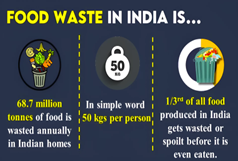
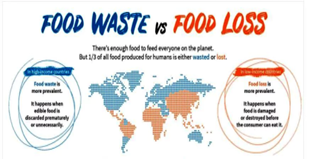
Importance of Food:
- Food is vital to human life, health, culture, and the economy, encompassing several key aspects:
- Nutritional Value: Food provides essential nutrients and energy necessary for the body's proper functioning, including proteins, carbohydrates, fats, vitamins, and minerals.
- Economic Impact: The food sector—spanning agriculture, food processing, and distribution—serves as a major employment source and economic driver.
- Religious and Cultural Significance:
- Traditional foods and culinary practices are central to cultural identity and community rituals.
- Historical deities, like those in Pagan and Hindu traditions, were often associated with food production, including Earth, rivers, and rain.
Crucial Insights on Food Safety and Wastage:
- As India aims to achieve Viksit Bharat by its 78th year of Independence, advancing food safety and minimising waste are critical:
- Food Safety and Security: Ensuring the safety of food and reducing loss and waste are essential to provide sufficient and nutritious food for all.
- Food Wastage: The Food Waste Index Report 2024 reveals that in 2022, the world wasted 1.05 billion tonnes of food, approximately one-fifth of the food available to consumers at various levels, including retail, food service, and households.
- Food Irradiation Units: To support the Sustainable Development Goals 2 (Zero Hunger), the Union Budget for 2024-25 has allocated funds for establishing 50 multi-product food irradiation units in the MSME sector.
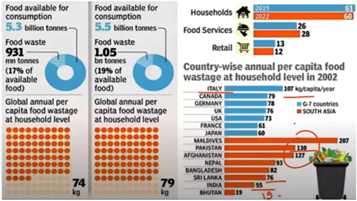
About Food Safety and Security:
- Food Safety: This involves the proper handling, preparation, and storage of food to prevent foodborne illnesses and ensure it is safe for consumption.
- Food Security: As defined by the 1996 World Food Summit, food security means that all individuals have reliable physical and economic access to adequate, safe, and nutritious food that fulfils their dietary needs and preferences for a healthy and active life.
- Key Aspects of Food Safety:
- Contamination:
- Biological Contaminants: Pathogens such as bacteria (e.g., Salmonella, E. coli), viruses, and parasites that can lead to foodborne diseases.
- Chemical Contaminants: Residues from pesticides, heavy metals, and other chemicals that pose health risks.
- Physical Contaminants: Foreign objects like glass, metal fragments, or plastic that can cause injuries or health problems.
- Food Adulteration: The practice of adding inferior or harmful substances to food to increase its quantity or improve its appearance.
- Hygiene and Sanitation: Inadequate hygiene practices, such as improper handwashing, unsanitized surfaces, and improper food storage and cooking, exacerbate food safety risks.
- Food Safety Regulations: Strict or rigid regulations may lead to the discarding of edible food or its conversion into compost.
- Contamination:
- In India, the Food Safety and Standards Authority of India (FSSAI) is responsible for ensuring that food products comply with safety and quality standards.
- Four Main Dimensions of Food Security:
- Physical Availability of Food: Refers to the availability of food supply, determined by food production levels, stock, and net trade.
- Economic and Physical Access to Food: Focuses on income, expenditure, markets, and prices to address issues of food access and achieve food security.
- Food Utilisation: Relates to how effectively the body absorbs and uses the nutrients from food.
- Stability of Access: Involves maintaining consistent food access over time to prevent periodic inadequacies that could affect nutritional status.
Major Reasons Leading to Food Wastage:
- Food wastage involves the loss or discard of edible food at various stages of the supply chain:
- Post-Harvest Losses:
- A substantial amount of food is lost during harvesting, storage, and transportation due to poor infrastructure, inadequate storage, and inefficient supply chains.
- India experiences annual post-harvest losses of approximately ₹1,52,790 crore, according to a 2022 Ministry of Food Processing Industries report.
- Retail and Consumer Waste:
- Retail Level:
- Waste occurs due to overstocking, product damage, or expiration.
- Consumer Level:
- Waste arises from over-purchasing, improper storage, and food spoilage.
- The UNEP Food Waste Index Report 2024 shows that 60% of food waste occurs in households, 28% in food services, and 12% in retail.
- Retail Level:
- Post-Harvest Losses:
About Food Irradiation Technology:
- About:
- Food irradiation is a method employed to enhance food safety and extend shelf life by eliminating or reducing microorganisms and insects responsible for foodborne illnesses and spoilage.
- Irradiation Process:
- Ionising Radiation: The process involves exposing food to ionising radiation, which consists of energy in the form of waves or particles. Types of ionising radiation used include:
- Gamma Rays: Emitted by radioactive isotopes such as Cobalt-60 or Cesium-137.
- X-rays
- Electron Beams
- Effect on Microorganisms:
- Ionising radiation disrupts the DNA of microorganisms, including bacteria, viruses, and parasites, rendering them inactive or killing them. This prevents foodborne illnesses and minimises spoilage.
- Impact on Food:
- The irradiation process does not significantly increase the food's temperature, so it does not cook the food.
- Most foods retain their nutritional value, taste, texture, and appearance, although very high doses may alter certain properties.
- Ionising Radiation: The process involves exposing food to ionising radiation, which consists of energy in the form of waves or particles. Types of ionising radiation used include:
- Applications of Food Irradiation Technology to Reduce Food Wastage:
- Pathogen Reduction: Eliminates harmful microorganisms such as Salmonella, E. coli, and Listeria.
- Disinfestation: Controls insect pests.
- Shelf Life Extension: Prolongs the usability of food products.
- Quarantine Treatment: Addresses pest issues in compliance with regulations.
Measures to Reduce Food Wastage:
- Improved Supply Chain Efficiency:
- Enhance inventory management systems in grocery stores and restaurants.
- Optimise transportation logistics to minimise food spoilage during transit.
- Government Policies and Regulations:
- Standardise food expiration labels, such as “best before” and “use by,” to reduce unnecessary disposal of edible food.
- Technology and Innovation:
- Smart Packaging: Invest in packaging technologies that extend product shelf life.
- Food Waste Apps: Support applications that track food at risk of wastage and connect excess food with those in need.
- Restaurant and Hospitality Industry Initiatives:
- Portion Control: Offer flexible portion sizes to match customer appetites.
- Doggy Bags: Encourage customers to take leftovers home.
- Buffet Waste Reduction: Implement policies to reduce waste in buffets, such as using smaller trays and providing frequent refills.
Major Initiatives Undertaken to Improve Food Safety and Security
- Food Safety and Standards Authority of India (FSSAI):
- Regulates and oversees food safety standards, setting science-based standards and regulating the manufacture, storage, distribution, sale, and import of food products.
- Public Distribution System (PDS) Reforms:
- Streamlines food grain distribution to enhance efficiency and reduce leakages through end-to-end computerization, Aadhar-linked ration cards, and e-POS devices at ration shops.
- Safe and Nutritious Food (SNF) Initiative:
- Promotes safe and nutritious food across various touch points such as homes, schools, workplaces, and eateries.
- Surveillance and Monitoring Programs:
- Regularly monitors and tests food products for contamination and adulteration through the National Food Laboratory Network and the Rapid Alert System for Food and Feed (RASFF).
- Food Recall Protocol:
- Facilitates the removal of unsafe food products from the market to protect consumers.
- International Collaborations:
- Partners with international bodies like the World Health Organization (WHO) and Codex Alimentarius to set and implement food safety standards.
Way Forward
- Expanding Food Irradiation Technology:
- Utilise allocated funds to expand food irradiation technology, focusing on capacity building, scaling up successful units, and improving stakeholder education.
- Strengthening Food Safety Standards:
- Enhance the FSSAI's capacity to regulate and monitor food products, enforce food safety regulations, and reduce food adulteration.
- Minimising Food Loss:
- Address food loss to improve food security, align with the UN 2030 goal of halving global food waste, and reduce losses along production and supply chains.
- Promoting Circular Economy:
- Divert food loss and waste towards livestock and poultry feed to reduce wastage.
- Policy Support and Governance:
- Provide incentives for MSMEs to adopt food safety technologies and integrate food safety policies with health, agriculture, and environmental policies.
- Setting Reduction Targets:
- Establish national and global targets for reducing food wastage and promote sustainable food production and consumption through education and awareness.
- Innovative Food Conservation Models:
- Support initiatives like Adrish, which focuses on zero-waste lifestyles, helping save significant amounts of packaging waste and plastic bags.
Conclusion
By focusing on these strategic measures, India can significantly enhance its food safety and security landscape, contributing to improved public health, reduced food wastage, and sustainable development goals.
|
UPSC Civil Services Examination Previous Year’s Question (PYQs) Prelims Q:1 With reference to the provisions made under the National Food Security Act, 2013, consider the following statements: (2018)
Which of the statements given above is/are correct?
Ans: (b)
Mains Q:1 What are the salient features of the National Food Security Act, 2013? How has the Food Security Bill helped in eliminating hunger and malnutrition in India? (2021) |
Source: IE
Share the article
Edukemy’s Current Affairs Quiz is published with multiple choice questions for UPSC exams
MCQ
Get Latest Updates on Offers, Event dates, and free Mentorship sessions.

Get in touch with our Expert Academic Counsellors 👋
FAQs
UPSC Daily Current Affairs focuses on learning current events on a daily basis. An aspirant needs to study regular and updated information about current events, news, and relevant topics that are important for UPSC aspirants. It covers national and international affairs, government policies, socio-economic issues, science and technology advancements, and more.
UPSC Daily Current Affairs provides aspirants with a concise and comprehensive overview of the latest happenings and developments across various fields. It helps aspirants stay updated with current affairs and provides them with valuable insights and analysis, which are essential for answering questions in the UPSC examinations. It enhances their knowledge, analytical skills, and ability to connect current affairs with the UPSC syllabus.
UPSC Daily Current Affairs covers a wide range of topics, including politics, economics, science and technology, environment, social issues, governance, international relations, and more. It offers news summaries, in-depth analyses, editorials, opinion pieces, and relevant study materials. It also provides practice questions and quizzes to help aspirants test their understanding of current affairs.
Edukemy's UPSC Daily Current Affairs can be accessed through:
- UPSC Daily Current Affairs can be accessed through Current Affairs tab at the top of the Main Page of Edukemy.
- Edukemy Mobile app: The Daily Current Affairs can also be access through Edukemy Mobile App.
- Social media: Follow Edukemy’s official social media accounts or pages that provide UPSC Daily Current Affairs updates, including Facebook, Twitter, or Telegram channels.

